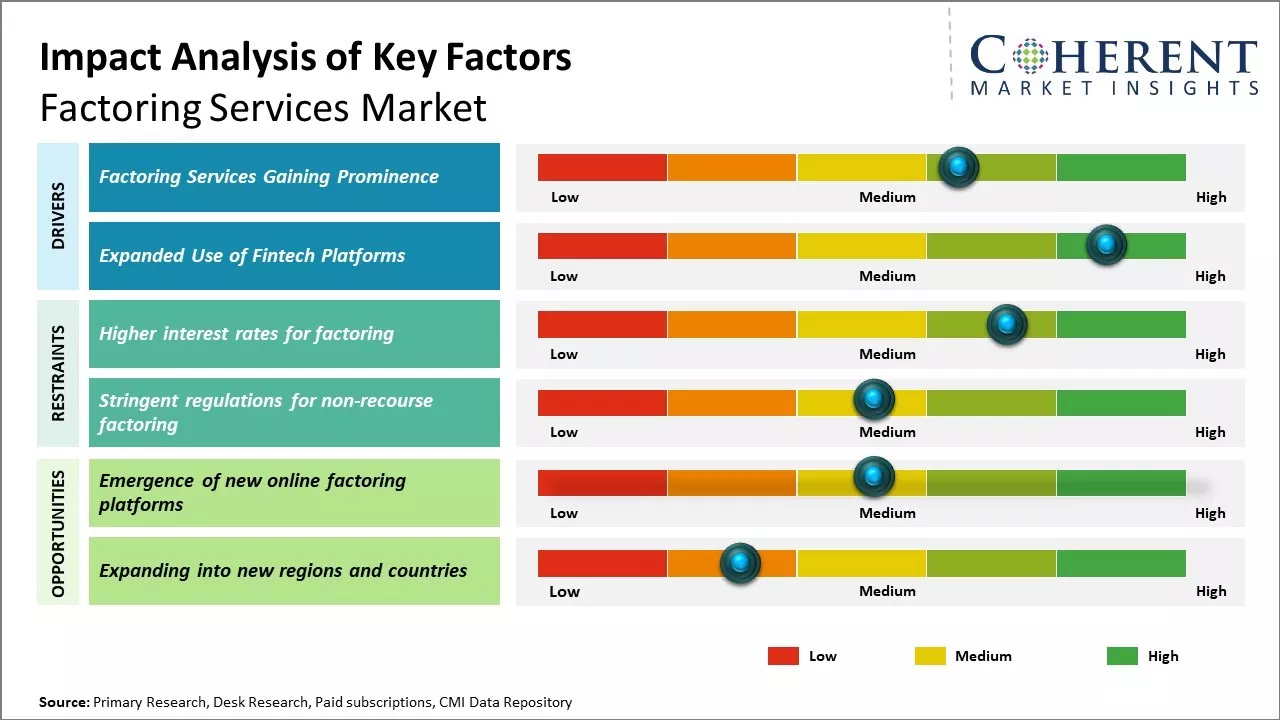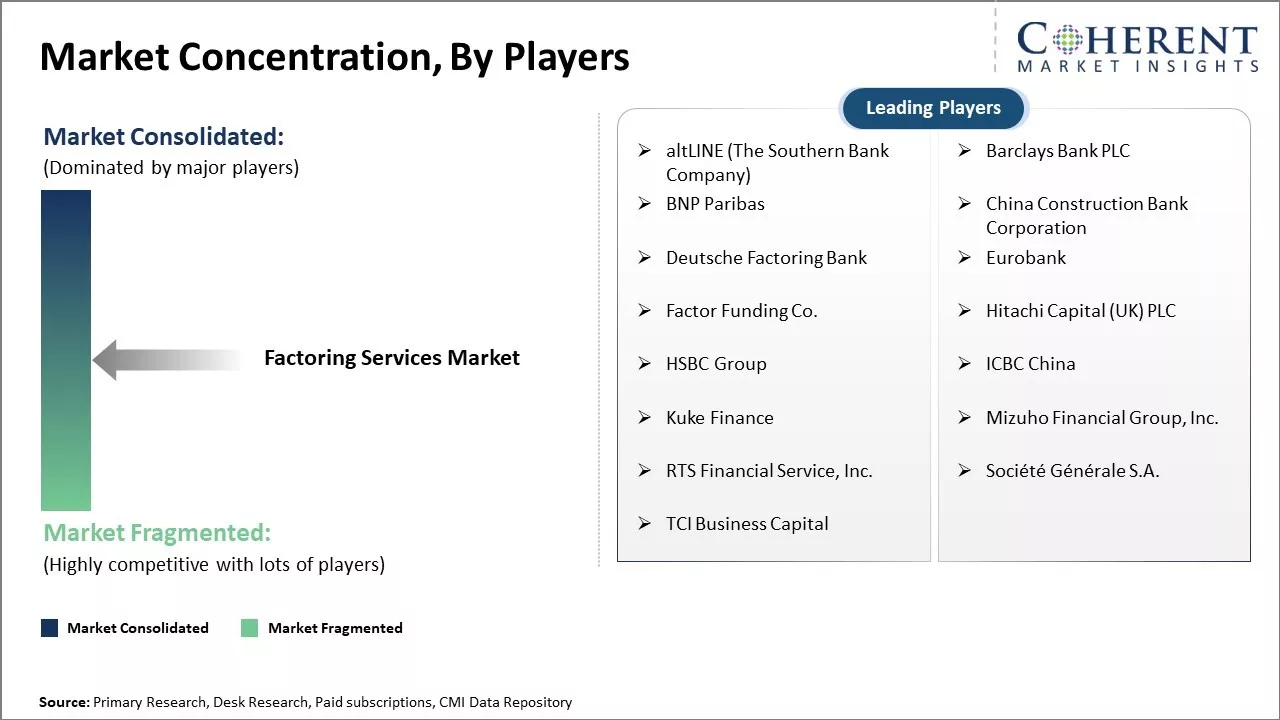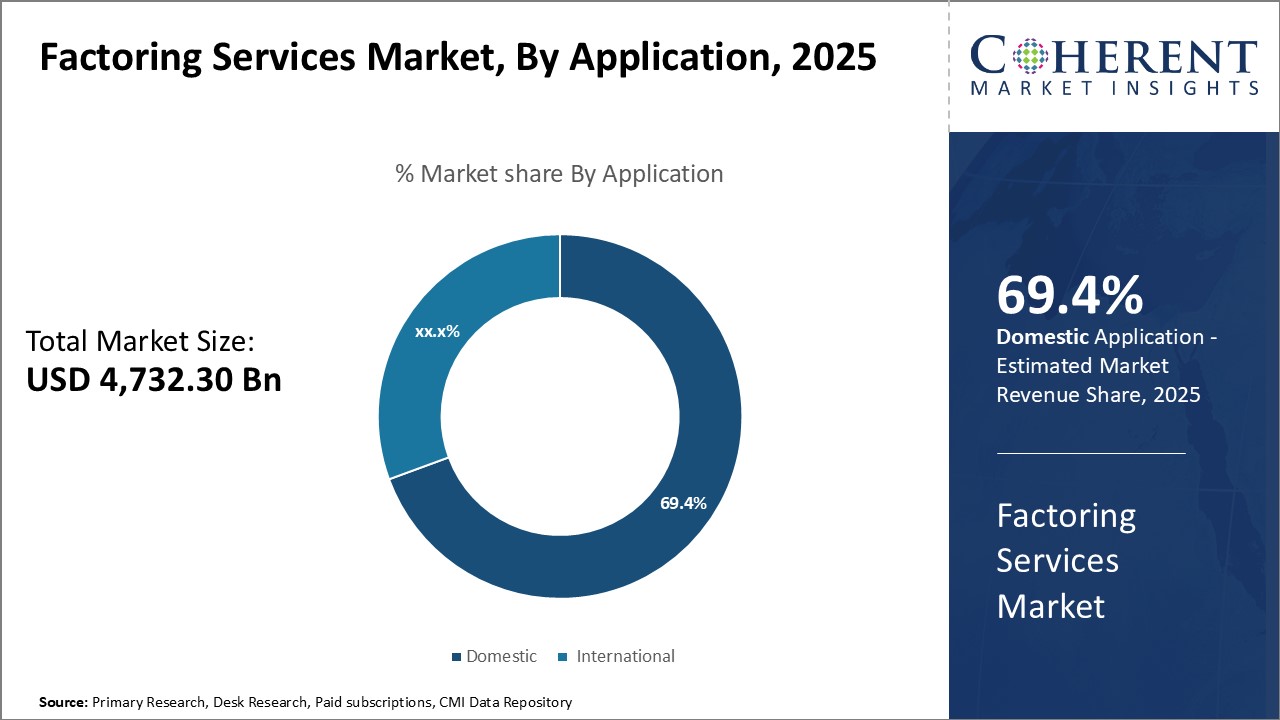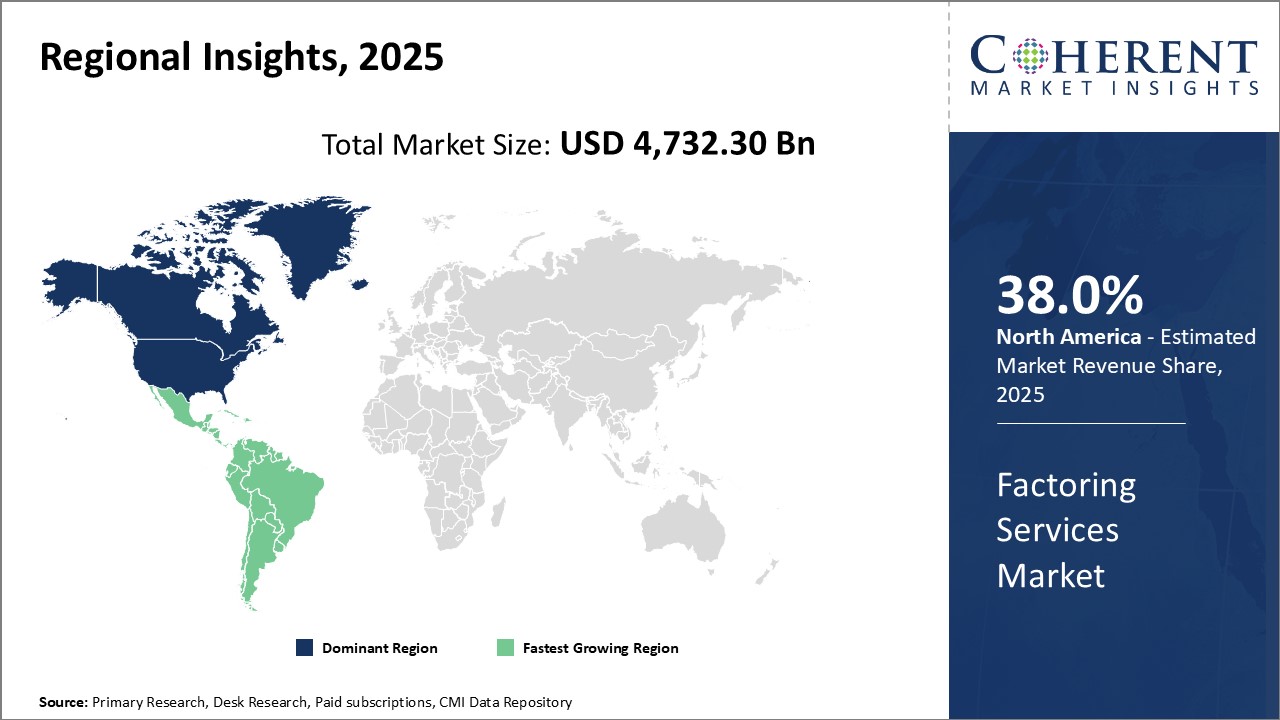Factoring Services Market Size and Trends
The Factoring Services Market is estimated to be valued at US$ 4,732.30 Bn in 2025 and is expected to reach USD 8,010.98 Bn by 2032, exhibiting a compound annual growth rate (CAGR) of 7.8% from 2025 to 2032.

Discover market dynamics shaping the industry: Download Free Sample
The growth in SMEs Small Medium Enterprises and focus of factoring services providers to penetrate untapped regional markets will drive the size of the factoring services market during the forecast period. The factoring services market is witnessing significant growth owing to the increasing adoption of factoring services by small and medium enterprises (SMEs) globally. Major factoring service providers are focusing on penetrating untapped regional markets by diversifying their service offerings and introducing digital payment methods. This is expected to increase SMEs' acceptance of factoring services in developing nations, thereby driving the overall market trend going forward.
Factoring Services Gaining Prominence
The factoring services market is witnessing significant growth in recent times primarily due to the increasing prominence of the factoring model amongst SMEs. Factoring provides a viable source of working capital for SMEs which helps them better manage cashflows and ongoing business expenses. Unlike traditional bank loans, factoring does not require SMEs to provide collateral or prove creditworthiness. This makes factoring highly attractive especially for newer and smaller businesses which otherwise find it difficult to access adequate financing through conventional channels.
By selling their receivables to a factor at a discounted rate, SMEs are able to monetize unpaid invoices almost instantly. This releases blocked funds and provides them flexibility to run business operations smoothly. Many SMEs have limited resources to dedicate for credit management functions like chasing delayed payments, handling disputes and enforcing collections. Partnering with a factoring firm helps SMEs outsource these non-core activities so that they can focus energy on growing the business. Factoring has thus emerged as an excellent alternative financing option relieving SME cashflow pressures and minimizing debtor risks. The availability of both domestic and international factoring models further augments choices for businesses involved in cross-border trade.
Market Concentration and Competitive Landscape

Get actionable strategies to beat competition: Download Free Sample
Expanded Use of Fintech PlatformsAnother key driver has been the growing use of digital platforms and technologies in the delivery of factoring services. Traditional factoring often involved paperwork intensive processes hindering efficiency and turnaround times. However, fintech driven disruptions are transforming factoring into a faster, transparent and streamlined process. Factoring firms are leveraging technologies like AI, blockchain and cloud computing to automate routine tasks, integrate with client ERP systems and offer real-time dashboards. Digital interfaces enable on-the-go management of receivables and real-time status tracking for clients. AI powered tools are also helping firms better assess client risks, streamline due diligence and optimize credit decisions.
The widespread usage of online invoicing tools by businesses has also facilitated integration with digital factoring platforms. Platforms are leveraging such digital footprints and alternate data sources to expedite the onboarding of clients. Advanced analytics further aids in monitoring portfolio health, detecting anomalies and improving collection outcomes. Fintech thus plays a vital role in removing constraints of traditional factoring while enhancing user experiences.
Key Takeaways of Analyst:
The factoring services market has strong growth potential over the next five years. The demand for working capital financing alternatives among small businesses continues to see an upward trajectory. Factoring allows businesses to convert outstanding invoices into immediate cash flow, providing a reliable source of operating funds. This increases business agility and the ability to seize new opportunities.
North America currently dominates the global factoring market due to widespread awareness and acceptance of this financing model. However, Europe is witnessing faster growth on the back of improving economic conditions following the recession. Rising international trade in Europe is driving more firms to rely on factoring services to better manage cash flow related to cross-border sales. The Asia Pacific region also presents a promising outlook and is expected to emerge as the fastest growing regional market.
On the other hand, lack of education remains a challenge, as many small businesses are still unaware of factoring as a financing option. High ongoing costs may also limit its appeal for businesses with intermittent cash needs. Stringent due diligence by factoring companies could pose difficulties for newer firms in establishing creditworthiness. Nonetheless, the continuous push for digitalization in the industry and introduction of new online platforms are making factoring services more accessible. This will help expand the potential customer base in the coming years.
Market Challenges: Higher interest rates for factoring
The industry is highly competitive with many companies offering similar services. Maintaining strong client relationships and keeping default rates low is crucial for retaining business but can be difficult to do at scale. Economic uncertainty makes forecasting client cash flows an inexact science. Adding new clients also presents risks as their creditworthiness and payment histories must be thoroughly evaluated. Younger firms may struggle to gain brand recognition and trust compared to larger, more established players.
Market Opportunities: Emergence of new online factoring platforms
As global trade increases in volume and complexity, more businesses will seek financing options for their accounts receivable. Invoice fraud is a growing problem that factoring can help remedy through its verification processes. Expanding into new industry verticals or international markets allows companies to diversify their client bases.

Discover high revenue pocket segments and roadmap to it: Download Free Sample
Insights, By Application: Demand for Working Capital Financing Drives Domestic FactoringIn terms of Application, Domestic is estimated to hold the highest share of the market owing 69.4% in 2025 to strong demand for working capital financing among domestic businesses. The domestic factoring industry in the country has seen significant growth over the past few years driven primarily by small and medium businesses that rely on invoice factoring as a source of short term financing.
Domestic companies engaged in trading have been the biggest clients for domestic factoring services. These businesses rely on credit sales for a large portion of their revenues. However, the time between shipping goods to clients and receiving payment can often stretch to 60-90 days. This delays cash collection and strains the company's working capital. By engaging in factoring, these companies are able to sell their invoices to a factor at a small discount, receive immediate payment and free up cash for further operations and growth.
Manufacturing SMEs have also gained significantly from factoring services. These businesses many a times struggle to secure adequate credit lines from banks to meet raw material procurement and production needs. Factoring invoices provides a flexible non-bank source of funding that grows in proportion to sales volumes. This helps them avoid disruptions in manufacturing due to cash flow issues.
Moreover, the priority sectors identified by the government including agriculture, healthcare and renewable energy have also contributed meaningfully to domestic factoring volumes. Businesses operating in these sectors receive preferential credit terms from factoring companies as part of the companies' corporate social responsibility initiatives. This has accelerated the adoption of factoring.
Overall, the widespread need for efficient working capital management solutions among a diverse set of domestic industries has propelled the growth of the domestic factoring market in the country over the past years. As long as access to affordable bank credit remains a challenge for businesses, factoring is likely to retain its appeal as a source of continuous non-bank financing.
Insights, By Enterprise Size: Large Enterprises Drive Economies of Scale in Factoring
In terms of enterprise size, Large Enterprises contribute the highest share to the Factoring Services market owing 69.1% in 2025 to their ability to generate significant factoring volumes. Given the proportionately higher fixed operating costs associated with factoring, providers focus on building business relationships with large corporates that can drive economies of scale.
Large multinational and domestic conglomerates with extensive supplier and dealer networks spread across the country offer sizable factoring opportunities. Being well-established names with substantial annual turnover and profitability, they are able to induce factoring companies to offer them competitive pricing terms through high volume commitments.
Large enterprises also have the financial resources to dedicate teams that can efficiently manage factoring programs in-house. Their scale allows factoring providers to customize technology-led invoice processing solutions tailored to their specific requirements. This creates a seamless experience that enhances client stickiness.
Furthermore, blue chip corporates often receive preferential credit terms from factoring firms on account of their strong brand equity and lower perceived risk. They take advantage of bulk discounts on interest rates to lower their supplier financing costs.
While SME factoring also presents opportunities, factors prioritize large clients that can generate a critical mass of invoice volumes to build a profitable portfolio. Strategic relationships with largest players aid expansion as factors gain credibility in the market through association with prominent brands. This highlights their focus on large enterprises for driving scale-based efficiencies in operations.
Insights, By Providers: Banks Lead the Market Supported by Established Franchise
In terms of providers, Banks contribute the highest share of the Factoring Services market owing 78.8% in 2025 to their incumbency advantage built over decades. Factoring is a natural extension of their trade finance offerings leveraging branch networks and client relationships.
Banks were among the earliest providers in the country to commence factoring activities. Over the years, they have strengthened distribution and acquired domain knowledge by serving diversified client segments. This gives them an unparalleled understanding of the diverse risks and requirements across industries.
Furthermore, banks benefit from lower customer acquisition and servicing costs relative to new entrants due to re-use of existing infrastructure and brand equity. Their status as trusted financial brands provides confidence to businesses in the integrity and security of factoring programs.
Banks also have the ability to seamlessly integrate factoring with their wide spectrum of cash, trade, working capital and channel financing products. This allows them to offer customized multi-product solutions tailored to specific client lifecycles. Such cross-selling strengthens stickiness in a competitive landscape.
While specialty Non-Bank Factors are growing rapidly, it will take time to match the deep market penetration and range of ancillary offerings provided by the established franchise of banks. As a result, banks are projected to continue dominating the provider landscape despite facing challenges from diversifying business models of NBFCs.
Regional Insights

Need a Different Region or Segment? Download Free Sample
North America represents the largest region in the global factoring services market and is estimated to account for 38.0% share in 2025, driven by strong demand from the well-established transportation and logistics industries. Countries such as the U.S. and Canada have a sizable transportation footprint, with major road, rail and shipping infrastructure across borders. This facilitates domestic and international trade activities on a large scale.
The presence of prominent factoring firms in the region that can handle large invoice volumes has supported businesses of all sizes. Cross-border transactions between NAFTA nations are common. Leading transportation companies rely on factoring to efficiently manage cash flows and continue their operations smoothly. The dominance of US dollar as a globally accepted currency also makes international trade simpler within North America.
The factoring services market in Latin America has been witnessing rapid growth recently on the back of rising B2B commerce. Countries such as Brazil and Mexico are pacing ahead as they promote regional trade integration through trade agreements. This has augmented business partnerships and cross-selling opportunities for factoring providers.
An improving macroeconomic environment with steady GDP expansion is encouraging more companies to export goods and services. Favorable government initiatives to boost manufacturing and boost lending are complementing private investments into transport, mining and energy sectors. This is translating into higher invoice transaction volumes serviced by factoring firms. Their presence is gradually increasing across major cities to address varying needs of SMEs involved in domestic as well as international businesses. The consistent rise in international shipments signifies continued demand for working capital and risk management tools like factoring.
Market Report Scope
Factoring Services Market Report Coverage
| Report Coverage | Details | ||
|---|---|---|---|
| Base Year: | 2024 | Market Size in 2025: | USD 4,732.30 Bn |
| Historical Data for: | 2020 To 2024 | Forecast Period: | 2025 To 2032 |
| Forecast Period 2025 to 2032 CAGR: | 7.8% | 2032 Value Projection: | USD 8,010.98 Bn |
| Geographies covered: |
|
||
| Segments covered: |
|
||
| Companies covered: |
altLINE (The Southern Bank Company), Barclays Bank PLC, BNP Paribas, China Construction Bank Corporation, Deutsche Factoring Bank, Eurobank, Factor Funding Co., Hitachi Capital (UK) PLC, HSBC Group, ICBC China, Kuke Finance, Mizuho Financial Group, Inc., RTS Financial Service, Inc., Société Générale S.A., and TCI Business Capital |
||
| Growth Drivers: |
|
||
| Restraints & Challenges: |
|
||
Uncover macros and micros vetted on 75+ parameters: Get instant access to report
Factoring Services Industry News
- In January 2023, GE and KUKE, Poland's Export Credit Agency (ECA), formed a strategic partnership in export finance worth US$ 1.06 billion (EUR 1 billion). This collaboration aims to assist GE's global energy clients in reducing carbon emissions and promoting electrification. Under the agreement, GE's Polish operations will work with KUKE to secure debt insurance for specific transactions, facilitating significant investments in renewable and gas-powered projects worldwide through Polish exports and the supply chain.
- In October 2022, BNP Paribas completed the acquisition of Kantox, a leading fintech company specializing in automated currency risk management. Kantox's software streamlines corporate foreign exchange processes with its API-driven solution, aligning perfectly with BNP Paribas' Growth Technology Sustainability 2025 strategy. This acquisition aims to accelerate technological innovations, enhance customer experiences, and offer advanced capabilities to BNP Paribas' clients in the cross-border payments sector.
- In March 2023, BNP Paribas teamed up with Hokodo to introduce a Buy Now, Pay Later (BNPL) solution platform. This platform allows large international companies to offer their business clients flexible payment options. Leveraging Hokodo's B2B BNPL platform and BNP Paribas' expertise and financial stability, this cutting-edge solution combines advanced cash management and factoring capabilities to provide a seamless BNPL experience.
- In the same month, FINAMCO and Tradewind Finance (Germany), a leading trade finance service provider, joined forces to enhance factoring services for businesses in Colombia and neighboring regions. Both specializing in international factoring, these companies aimed to leverage their expertise and global networks to offer affordable and efficient financing solutions to Latin American businesses. Through this partnership, Tradewind sought to establish itself as a competitive alternative lender in Latin America, where access to trade finance has historically been limited.
*Definition: Factoring services refer to financial services provided by Factoring companies to businesses. These companies purchase accounts receivable owed to businesses by their customers at a discounted rate. This allows businesses to access cash from their outstanding invoices right away. In return, the factoring company takes on the responsibility of collecting payments from customers and the risk of bad debts. Factoring services provide an alternative source of financing to businesses.
Market Segmentation
- Application Insights (Revenue, USD BN, 2020 - 2032)
- Domestic
- International
- Enterprise Size Insights (Revenue, USD BN, 2020 - 2032)
- Large Enterprises
- SMEs
- Provider Insights (Revenue, USD BN, 2020 - 2032)
- Banks
- NBFCs
- Industry Vertical Insights (Revenue, USD BN, 2020 - 2032)
- Construction
- Manufacturing
- Healthcare
- Transportation & Logistics
- Energy & Utilities
- IT & Telecom
- Staffing
- Others
- Regional Insights (Revenue, USD BN, 2020 - 2032)
- North America
- U.S.
- Canada
- Latin America
- Brazil
- Argentina
- Mexico
- Rest of Latin America
- Europe
- Germany
- U.K.
- France
- Italy
- Russia
- Rest of Europe
- Asia Pacific
- China
- India
- Japan
- Australia
- South Korea
- ASEAN
- Rest of Asia Pacific
- Middle East & Africa
- GCC Countries
- South Africa
- Rest of Middle East & Africa
- North America
- Key Players Insights
- altLINE (The Southern Bank Company)
- Barclays Bank PLC
- BNP Paribas
- China Construction Bank Corporation
- Deutsche Factoring Bank
- Eurobank
- Factor Funding Co.
- Hitachi Capital (UK) PLC
- HSBC Group
- ICBC China
- Kuke Finance
- Mizuho Financial Group, Inc.
- RTS Financial Service, Inc.
- Société Générale S.A.
- TCI Business Capital
Share
Share
About Author
Monica Shevgan has 9+ years of experience in market research and business consulting driving client-centric product delivery of the Information and Communication Technology (ICT) team, enhancing client experiences, and shaping business strategy for optimal outcomes. Passionate about client success.
Missing comfort of reading report in your local language? Find your preferred language :
Transform your Strategy with Exclusive Trending Reports :
Frequently Asked Questions
EXISTING CLIENTELE
Joining thousands of companies around the world committed to making the Excellent Business Solutions.
View All Our Clients
